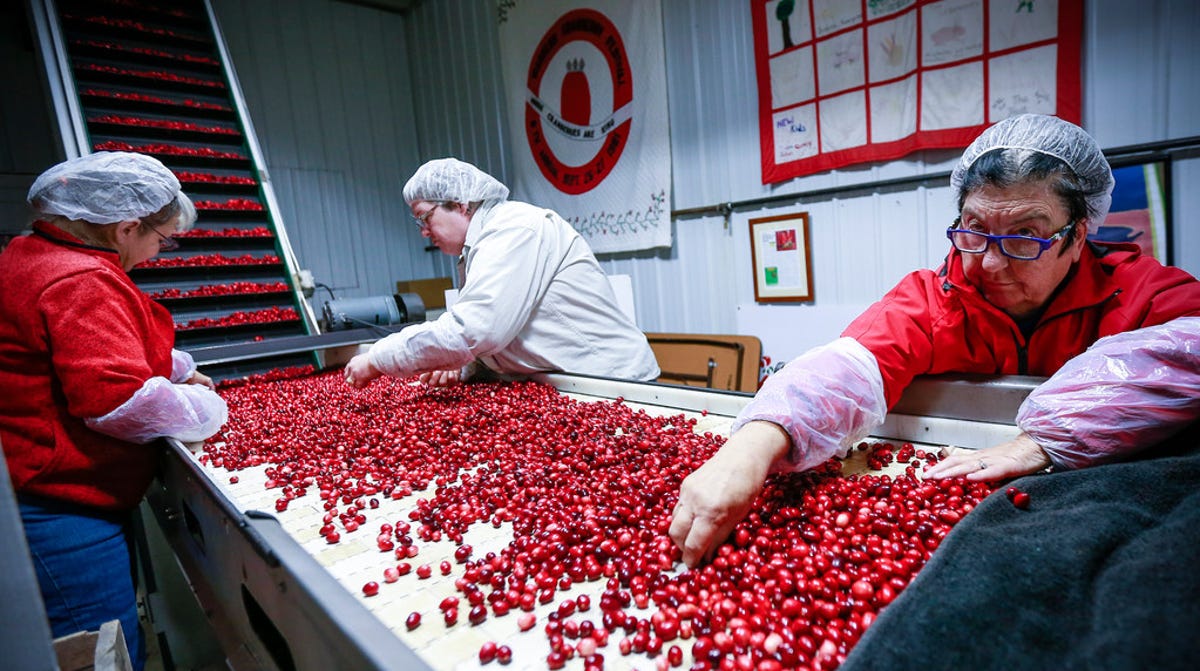Wisconsin
What’s the most Wisconsin Thanksgiving dinner you could eat? Here’s what the data shows

From mashed potatoes to canned cranberries, the agricultural industry in Wisconsin produces many of our Thanksgiving favorites.
This year, we at the Milwaukee Journal Sentinel wondered: what’s the most Wisconsin Thanksgiving dinner you could eat?
Like any news organization worth its salt and pepper, we turned to the data.
Wisconsin’s main agricultural products include many of America’s Thanksgiving favorites
We identified 19 popular Thanksgiving foods produced in Wisconsin, and compared the state’s total annual production of each using data from the U.S. Department of Agriculture. The result is a 6 million-ton “plate” of food our state generated last year.
It’s a nontraditional, but extremely cheesehead, Thanksgiving meal.
A Thanksgiving meal scaled to Wisconsin’s agricultural output would predictably include more cheese than most traditional plates, as Wisconsin produced 1.8 million tons of cheese last year. That’s the weight of almost 9,000 Boeing 747 airliners.
Our state’s turkey-day dinner plate is ultimately more plant than poultry, given that it produced almost 2.5 million tons of vegetables, fruits, grains, and legumes last year. (That doesn’t include 3.4 million tons of soybeans, or any commodities not surveyed in 2022.)
Some products had to be excluded for clarity, including more than 16 million tons of milk. When included, the volume of these items dwarfs the Thanksgiving foods we recognize.
Scaled for Wisconsin production, turkey would make up just a tiny portion of the dinner plate. More than 3 million turkeys were slaughtered in Wisconsin last year, and turkeys even outnumber humans in some parts of the state, like Barron County. But Wisconsin’s turkey output pales in comparison to other products like potatoes, corn and wheat.
Ashley Hagenow is Wisconsin’s 76th Alice in Dairyland, and spoke about Wisconsin’s agricultural production on behalf of the state Department of Agriculture, Trade and Consumer Protection.
She said Wisconsin leads the U.S. in production of cheese, producing a quarter of the nation’s cheese each year.
“We are very proud of the tradition of cheese-making here in Wisconsin,” Hagenow said. “We are home to 600 styles, types, and varieties of cheeses.”
In addition to cranberries, Hagenow pointed out that Wisconsin leads the nation in the production of several other Thanksgiving favorites. The state ranks first in the nation in production of green beans, second in butter, and third in potatoes.
America depends on Wisconsin for some classics, like cranberries
No discussion of Thanksgiving production in Wisconsin would be complete without a look at our state’s favorite berry, the cranberry.
Wisconsin produces almost two-thirds of the world’s cranberries. They have been harvested in Wisconsin for as long as people have lived here, said Allison Jonjak, cranberry outreach specialist at the University of Wisconsin-Extension, who grew up on a cranberry marsh herself.
“This really represents America, and it happens to be harvested right before Thanksgiving,” Jonjak said. “Cranberries are ready right now, they’re emblematic of North America, and they go really well with most meats.”
In 2022, Wisconsin cranberry producers grew almost five million barrels. This equates to roughly 240,000 tons of our state fruit.
Cranberry farmers proved resistant to this year’s drought, producing more cranberries than last year, Jonjak said.
And while Jonjak didn’t settle the canned-versus-whole-berry debate once and for all, she did share her preferences.
“I usually eat them raw while I’m harvesting them. During Thanksgiving, I’m a whole-berry sauce kind of person,” Jonjak said. Of the canned version, she said simply: “It’s also tasty.”
Wisconsin’s agricultural heritage is facing challenges
Although agriculture is central to Wisconsin’s identity, the state has lost a significant amount of farmland to residential and commercial development in recent years, and young farmers say finding affordable land is increasingly difficult.
Wisconsin’s farming industry also poses some environmental challenges that scientists and advocates are trying to address, including drinking water contamination from common fertilizers and using groundwater stores for irrigation.
“The biggest water quality challenge we have in the state is related to agricultural impacts,” said Sara Walling, water and agriculture program director at Clean Wisconsin, an environmental advocacy group.
Walling said the relative abundance of water in Wisconsin makes it even more important that environmental advocates and farmers find ways to protect it.
“The use of water to grow the crops that we have here is going to be a lot less intense than the water use is going to need to be in California, for instance,” Walling said.
Jonjak encouraged consumers to support the state’s agricultural heritage by buying Wisconsin products when possible.
“Buying a Wisconsin commodity, not only cranberries … helps keep our economy strong,” she said. “Anything that consumers can do to support farmers individually but also the whole agricultural ecosystem is huge.”

Wisconsin
Wisconsin former four-star quarterback Mabrey Mettauer appears headed for transfer portal
MADISON – It appears that the Wisconsin football team will have almost a completely new quarterback room next season.
Mabrey Mettauer, the last scholarship player left at the position on the roster from this season, is expected to enter the transfer portal, according to 247sports. The 6-foot-4, 230-pound true freshman from The Woodlands, Texas, was a consensus four-star recruit coming out of high school.
This season he served as the top backup to Braedyn Locke after Tyler Van Dyke suffered a season-ending knee injury against Alabama. Mettauer appeared in one game and completed his only pass attempt.
He maintained his redshirt status and will have four years of eligibility remaining.
Mabrey’s departure was the last domino to fall from the firing of Phil Longo as offensive coordinator. Like Van Dyke and Locke, Mettauer came to Wisconsin with the idea that he would play in Longo’s pass-friendly offense.
Locke’s brother, Landyn, a member of the 2025 recruiting class, was also recruited by Longo. Landyn Locke has been released from his letter of intent and has re-opened his recruitment.
After 247sports broken the news of Mettauer’s expected departure he reposted the post on his X and Instagram accounts.
The loss of Mettauer means Wisconsin has three scholarship quarterbacks plus walk-on Milos Spasojevic on the roster for next season:
* Billy Edwards Jr., who started this season at Maryland and threw for 2,800 yards. He has one year of eligibility left.
* Danny O’Neil, who started at San Diego State as a true freshman and threw for 2,000 yards this season. He has three years of eligibility remaining.
* Carter Smith, a four-star prospect from Florida, will enroll early and participate in spring practice.
Wisconsin
14-year-old killed in Wisconsin school shooting shared gifts of music and art with many, friends say

MADISON, Wis. — Rubi Patricia Vergara was a talented young teenager who often handcrafted gifts for others and shared her musical talents with many, family friends recounted at funeral services held Saturday morning.
Vergara, 14, was a student at Abundant Life Christian School in Madison, Wisconsin, where she was shot and killed by a fellow student Monday. Teacher Erin West, 42, was also killed in the attack.
“She was a quiet, gentle spirit who cared deeply for others,” City Church lead pastor Tom Flaherty said. “But Rubi also had a faith beyond her years.”
Vergara’s services were held at City Church, which is adjacent to the school. West’s funeral is set for Monday at Doxa Church in Madison, according to her obituary.
Two other injured students remained hospitalized Saturday in critical condition but were stable, UW Hospital said.
A family friend, Dawn Moris, spoke about Vergara’s compassion and empathy. Vergara made personalized birthday cards for loved ones with digital artwork, origami and had started crocheting. Moris showed those in the congregation a small crocheted smiley face potato crafted by Vergara.
“She applied a caring and creative approach to everything she did,” Moris said.
Vergara played keyboard in a family worship band and could hear a song and pick it up on the piano, Moris said. As a singer, she had a special talent of harmonizing and “sang like an angel,” Moris said.
Vergara’s aunt played her niece’s favorite song, “Shoulders” by for King & Country, on the guitar during the service. Her uncle, Andy Remus, thanked the people of Madison for supporting his family this past week.
Police say the shooter, 15-year-old student Natalie “Samantha” Rupnow, shot herself at the school and died at a Madison hospital. Police have said she was in contact with a man in California who authorities say was planning to attack a government building. Rupnow’s motivation for the attack remains a key part of their investigation.
Volmert reported from Lansing, Michigan.
This article was generated from an automated news agency feed without modifications to text.
Wisconsin
Teenager accused in Wisconsin school shooting had a tumultuous family life, court documents show

MADISON, Wis. — A 15-year-old girl who police say killed two people and wounded multiple others at a private Christian school in Wisconsin endured what appeared to be a tumultuous home life marked by divorces, custody battles and a series of court-mandated mediation sessions to resolve disputes over her care, according to court documents obtained by NBC News.
Jeff and Mellissa Rupnow married and divorced twice, during which their daughter Natalie Rupnow would at times travel between her parents’ homes every few days and attend therapy.
They married in 2011 and divorced for the first time in 2014, according to court documents.
The two agreed to joint custody of Natalie, but she would live primarily with her mother, the documents state.
They remarried in 2017, according to their marriage certificate obtained by NBC, but filed for divorce a second time in 2020. Mellissa and Jeff Rupnow again agreed to share custody of Natalie, but this time she would spend “equal time with both parents,” the court documents show. A divorce certificate obtained by NBC News shows their divorce was finalized in 2021.
Natalie Rupnow, who also went by Samantha, shot and killed a teacher and a student and wounded six others during study hall on Monday at Abundant Life Christian School in Madison, Wisconsin, before dying from an apparent self-inflicted gunshot wound, police said. The victims were identified as Erin M. West, 42, and Rubi P. Vergara, 14.
Two students who sustained life-threatening injuries during the shooting remained in the hospital and the other four injured have been discharged, police said.
The FBI detained Alexander Paffendorf, 20, in California earlier this week and ordered him to temporarily surrender his firearms after he allegedly communicated with Natalie Rupnow. Authorities say Paffendorf admitted to discussing plans with Rupnow to arm himself with explosives and target a government building. The FBI uncovered messages between the two but did not disclose their alleged plans.
Paffendorf and his family could not immediately be reached for comment.
The apparent turmoil in Natalie Rupnow’s family life, as documented by court records, offer a glimpse into events that may have shaped her path before Monday’s tragedy.
In 2022, Mellissa and Jeff Rupnow sought mediation for custody of Natalie. That May, Dane County Family Court Services notified the parents of a requirement to attend a “mandatory parent education program via Zoom” due to a “disagreement concerning child custody and/or physical placement.” A month later, according to court documents, Mellissa Rupnow had “been scheduled to attend on June 2nd and June 16, 2022, but did not appear” for the Parent Education Program. Shortly after, the couple was asked to appear for a “mandatory mediation session in person appointment.”
In July 2022, an agreement was reached, granting them joint legal custody of Natalie, who would primarily live with her father, according to court documents. The documents also indicate that the parents agreed to “consider Natalie’s therapist’s recommendations regarding placement” for Natalie during the weekends.
Natalie’s mother agreed to connect with her therapist and “participate in therapy to the extent recommended by the therapist,” according to the court documents. Natalie’s father would make “every effort to schedule therapy appointments” to accommodate the mother’s schedule.
The court documents noted that “the parents report a generally positive co-parenting relationship and will continue to communicate with one another by text messages and phone conversations.”
Jeff and Mellissa Rupnow did not respond to multiple requests for comment. Madison Police Chief Shon Barnes said the two are “fully cooperating” with investigators, who are still trying to identify a motive and have not released many details on the teenager.
“Identifying a motive is our top priority. But at this time, it appears that the motive was a combination of factors,” Barnes said at a news conference.
Trish Kilpin, the director of Wisconsin’s Office of School Safety, said on Monday that “targeted violence is preventable.”
“When somebody decides to use violence, it’s often to redress an upset or a grievance, and they progress down a pathway towards that violence,” Kilpin said. “And when they do that, they often study previous school shooting incidents.”
A neighbor of Jeff Rupnow’s who spoke to NBC News expressed shock when he learned about the shooting and described Jeff as a “kind person.”
“He really helped us out,” said the neighbor, who did not want his name used out of fear of publicity about the case. “I know we’re still trying to piece everything together.”
The neighbor indicated he didn’t know Natalie, saying “the very limited things we knew, it’s horrifying for everyone, obviously, and just horrifying for the families of the school and those kids.”
Selina Guevara reported from Madison, and Chloe Atkins and Daniella Silva reported from New York City.
-

 Politics1 week ago
Politics1 week agoCanadian premier threatens to cut off energy imports to US if Trump imposes tariff on country
-
/cdn.vox-cdn.com/uploads/chorus_asset/file/25782636/247422_ChatGPT_anniversary_CVirginia.jpg)
/cdn.vox-cdn.com/uploads/chorus_asset/file/25782636/247422_ChatGPT_anniversary_CVirginia.jpg) Technology1 week ago
Technology1 week agoInside the launch — and future — of ChatGPT
-
/cdn.vox-cdn.com/uploads/chorus_asset/file/25789444/1258459915.jpg)
/cdn.vox-cdn.com/uploads/chorus_asset/file/25789444/1258459915.jpg) Technology1 week ago
Technology1 week agoOpenAI cofounder Ilya Sutskever says the way AI is built is about to change
-

 Politics1 week ago
Politics1 week agoU.S. Supreme Court will decide if oil industry may sue to block California's zero-emissions goal
-
/cdn.vox-cdn.com/uploads/chorus_asset/file/25546252/STK169_Mark_Zuckerburg_CVIRGINIA_D.jpg)
/cdn.vox-cdn.com/uploads/chorus_asset/file/25546252/STK169_Mark_Zuckerburg_CVIRGINIA_D.jpg) Technology1 week ago
Technology1 week agoMeta asks the US government to block OpenAI’s switch to a for-profit
-

 Politics1 week ago
Politics1 week agoConservative group debuts major ad buy in key senators' states as 'soft appeal' for Hegseth, Gabbard, Patel
-

 Business6 days ago
Business6 days agoFreddie Freeman's World Series walk-off grand slam baseball sells at auction for $1.56 million
-
/cdn.vox-cdn.com/uploads/chorus_asset/file/23951353/STK043_VRG_Illo_N_Barclay_3_Meta.jpg)
/cdn.vox-cdn.com/uploads/chorus_asset/file/23951353/STK043_VRG_Illo_N_Barclay_3_Meta.jpg) Technology6 days ago
Technology6 days agoMeta’s Instagram boss: who posted something matters more in the AI age


















